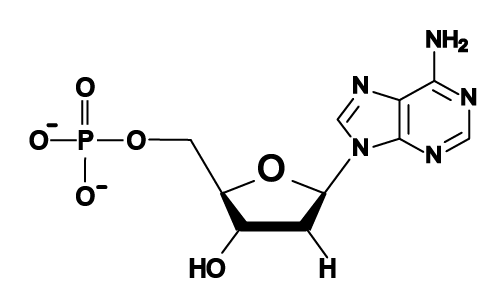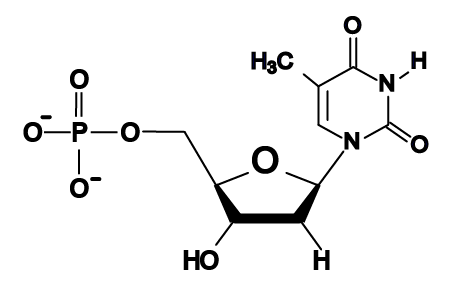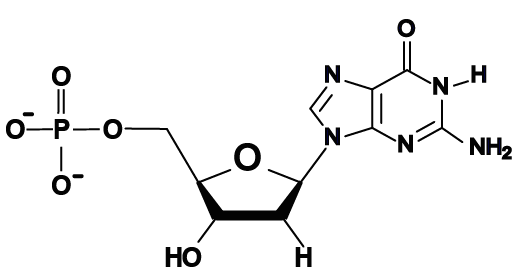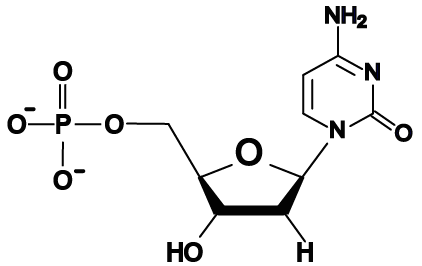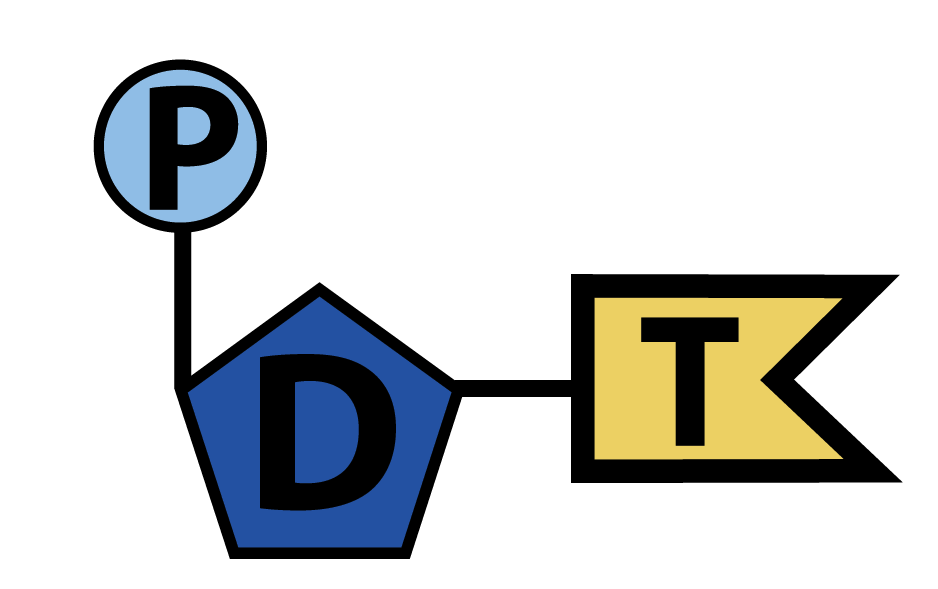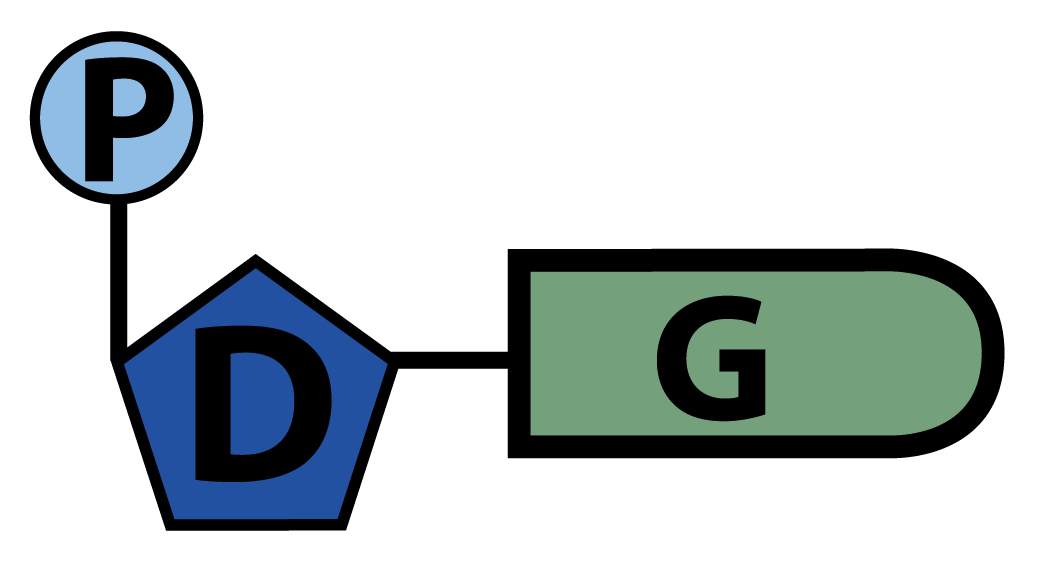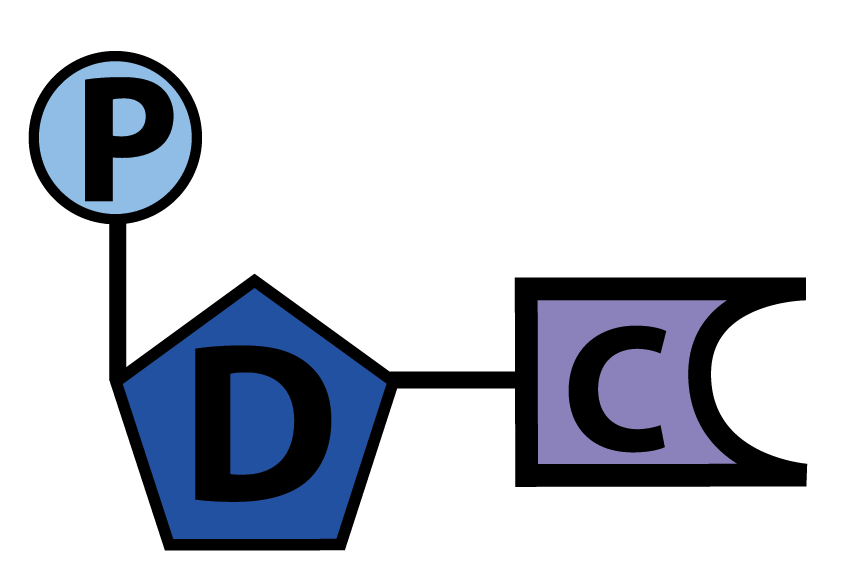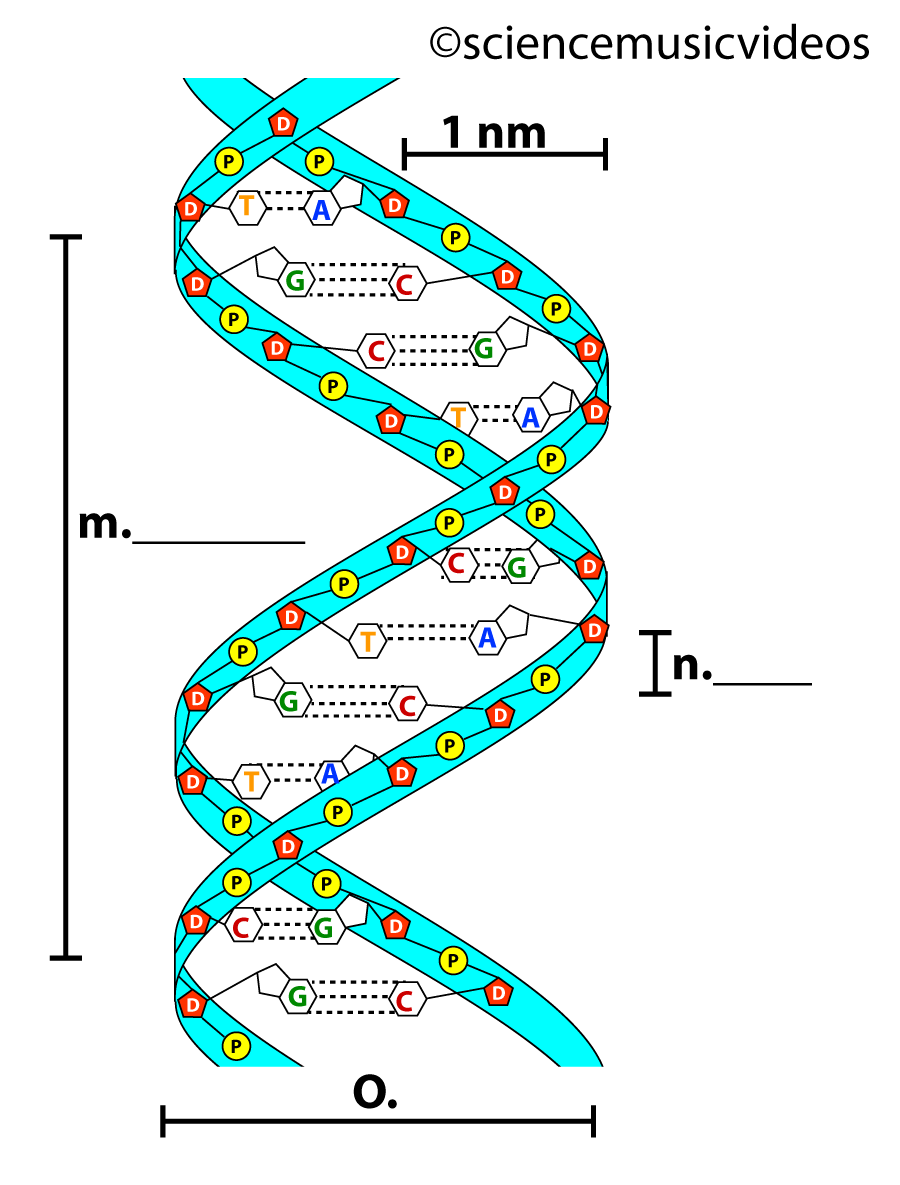Click the following link for a DNA Student Learning Guide (coming soon)
1. Introduction
In the last tutorial, we described DNA as biological software. DNA’s chemical structure allows it to serve as instructions. These instructions can control cells, telling them what proteins to make. These instructions are also the genes that parents pass on to their offspring. Why do you look like your parents? Because through their egg cell or sperm cell, they passed on instructions to build a body that looks like yours.
How can a molecule encode a set of instructions that tells a body how to grow? And, to connect that question to one of biology’s key ideas, ask yourself this: how can DNA’s structure enable it to carry hereditary information? That’s what the next few tutorials are about.
2. DNA is a long, skinny double helix
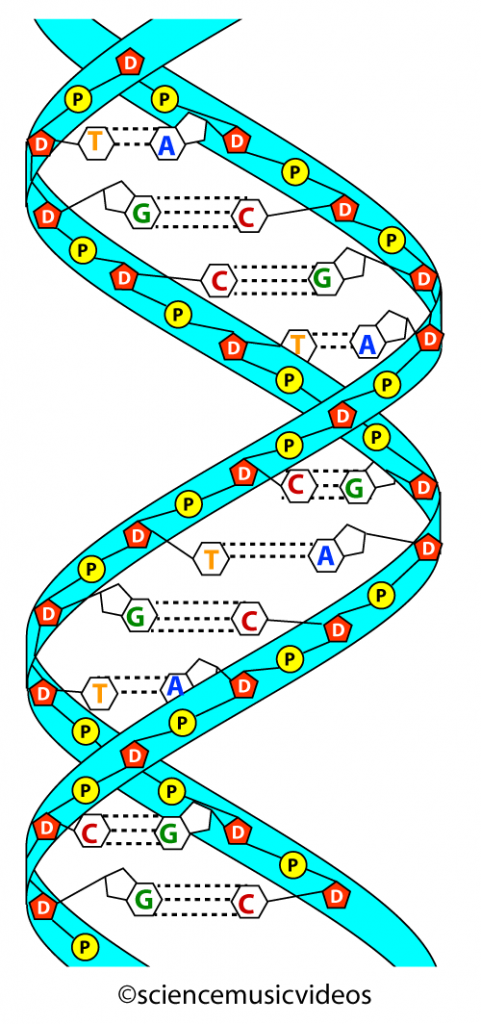
The image on the left is a model that shows some of the key features of DNA. You have to admit: it’s a very cool looking molecule.
DNA’s overall shape is a double helix. A helix is a coil, like a spring or a corkscrew. DNA is made up of two helices (plural for helix) that are twisted around one another.
If DNA were a country, it would be like Chile or Italy. If it were a state, it would be like California or Florida. It’s much longer than it is wide. How skinny is DNA? Incredibly skinny. It’s about 2 nanometers wide. A nanometer is a billionth of a meter.
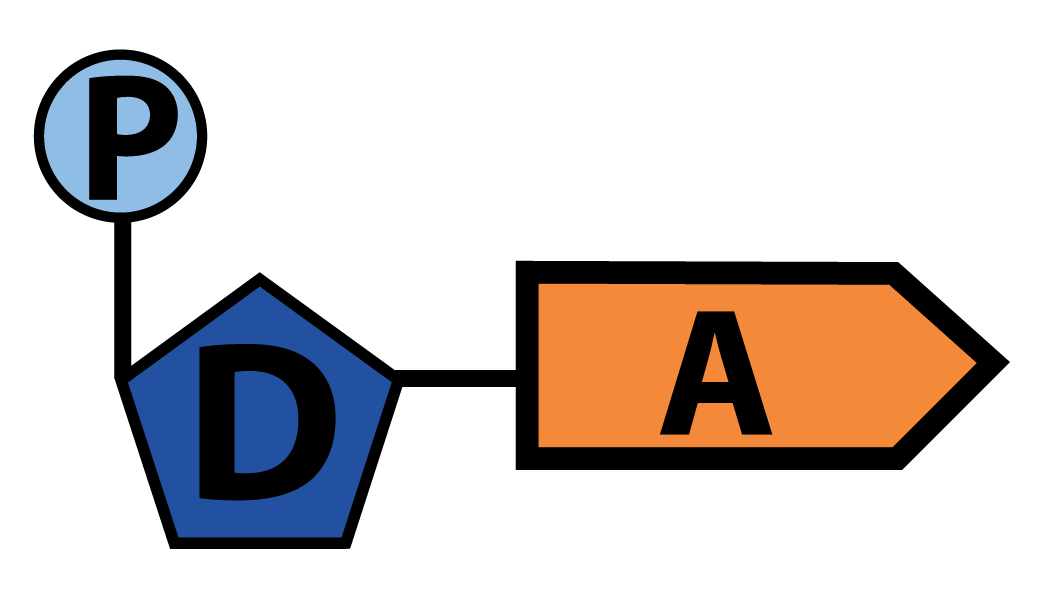
DNA’s length depends on where it’s found. In the DNA model on your left, try to identify one of the chemical units that repeat over and over again on each side of the double helix. Each unit has 3 sub-parts. These sub-parts are represented by a red pentagon with a “D,” a yellow circle with a “P,” and a hexagon with an “A,” a “T,” a “C,” or a “G.” One of these units (with different coloring) is shown in figure 2 on the right. These units are called nucleotides.
The nucleotide units on each side of the double helix form chemical bonds with one another. You can see these bonds in the middle of DNA, represented by two or three dotted lines. Two connected nucleotides are called base pairs. In the DNA model on your left, you can see one “T-A” base pair close to the top, followed by a “G-C” base pair, followed by a “C-G” base pair.
The number of base pairs is how we measure the length of DNA. In a virus that uses DNA as its genetic material, the DNA might have two thousand base pairs. Those two thousand base pairs make up the virus’s genome: its complete set of genetic information.
The genome of a bacterial species called E. coli — billions of which live in your large intestine — has about 4.6 million base pairs. The human genome, which is tightly packed up within the nucleus of each one of your cells, has about 3.2 billion base pairs1. If that DNA were unpacked, it would be about two meters (six feet) long (source: Genetics by the Numbers) . Why so much DNA? Remember that DNA is information: it takes a lot of information to tell a cell how to stay alive, and how to develop into a being as complex as you.
3. Understanding Nucleotides
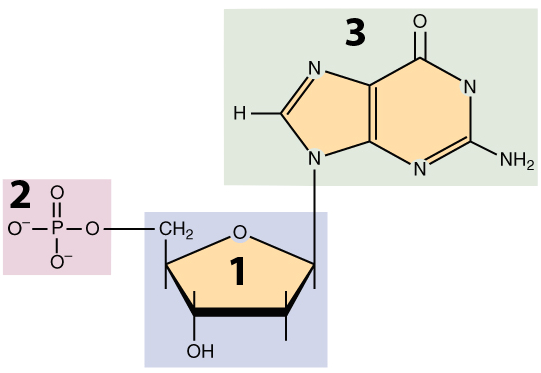
Nucleotides are the building blocks of DNA. You saw a simplified representation of one above in figure 2. A more detailed structural formula of a nucleotide is shown in figure 3 to your left. We’ll see below that these nucleotides function like the letters in an alphabet.
Each nucleotide has 3 subparts:
- Number 1 is a sugar called deoxyribose.
- Number 2 is a phosphate group. You can easily recognize it because of the “P” symbol in the middle, surrounded by four “Os.” The P represents the element phosphorus, and the O represents oxygen.
- Number 3 is what’s called a nitrogenous base. Find all the “N” symbols, which stand for nitrogen.
All nucleotides have a deoxyribose sugar and a phosphate group. The nitrogenous base can be one of four types. One type is called Adenine, usually referred to simply as “A.” The other three are Thymine (“T”), Guanine (“G”), and Cytosine (“C”).
Take a moment to examine the structural formulas in the table below. Just note the similarities and differences.
The four DNA nucleotides: structural formulas |
|
|
|
|
|
|
|
You don’t need to memorize these structures. You do need to know that
- There are four different nucleotides
- They’re represented by the letters A, T, G, and C
- The four letters enable DNA to function as an alphabet that can provide cells and organisms with genetic instructions.
Now that we’ve seen the structural formula for each nucleotide, we can switch to the simpler model that we introduced in figure 2 above. Study the table below for a moment, and then take the quiz that follows.
The Four DNA nucleotides: cartoon representations |
|
|
|
|
|
|
|
4. Checking Understanding: Nucleotides
[qwiz random = “true” qrecord_id=”sciencemusicvideosMeister1961-DNA, nucleotides (HS)”]
[h]Quiz: The Monomers of DNA
[q]In this diagram, the deoxyribose sugar is at
[textentry single_char=”true”]
[c]MQ ==[Qq]
[f]WWVzLiBUaGUgZGVveHlyaWJvc2Ugc3VnYXIgaXMgYXQgMQ==[Qq]
[c]Kg==[Qq]
[f]Tm8uIExvb2sgZm9yIHRoZSBwYXJ0IHRoYXQgaGFzIGEgcGVudGFnb25hbCAoNSBzaWRlZCkgc2hhcGUuIFRoYXQmIzgyMTc7cyBkZW94eXJpYm9zZS4=[Qq]
[q]In this diagram, the phosphate is at
[textentry single_char=”true”]
[c]Mg ==[Qq]
[f]WWVzLiBUaGUgcGhvc3BoYXRlwqBpcyBhdMKgMi4=[Qq]
[c]Kg==[Qq]
[f]Tm8uIExvb2sgZm9yIHRoZSBwYXJ0IHRoYXQgaGFzIGEgcGhvc3Bob3J1cyBhdG9tIGluIHRoZSBtaWRkbGUu[Qq]
[q]In this diagram, the nitrogenous base is at
[textentry single_char=”true”]
[c]Mw ==[Qq]
[f]WWVzLiBUaGXCoG5pdHJvZ2Vub3VzIGJhc2UgaXMgYXQgMw==[Qq]
[c]Kg==[Qq]
[f]Tm8uIExvb2sgZm9yIHRoZSBwYXJ0IHRoYXQgaGFzIGEgbml0cm9nZW4gYXRvbcKgaW4gaXQuIEFsc28sIHRoZSBOSA==Mg==IHBhcnQgbWFrZXMgaXQgYSBiYXNlLg==[Qq]
[q labels = “top”]
[l]sugar
[fx] No, that’s not correct. Please try again.
[f*] Excellent!
[l]phosphate
[fx] No. Please try again.
[f*] Excellent!
[l]nitrogenous base
[fx] No. Please try again.
[f*] Great!
[q labels = “top”]
[l]sugar
[fx] No, that’s not correct. Please try again.
[f*] Good!
[l]phosphate
[fx] No, that’s not correct. Please try again.
[f*] Great!
[l]nitrogenous base
[fx] No, that’s not correct. Please try again.
[f*] Good!
[/qwiz]
5. Sugar-phosphate bonds make up the “backbone” of a DNA strand.
DNA is a double helix, composed of two intertwined strands of nucleotides. Let’s look at the structure of each strand.
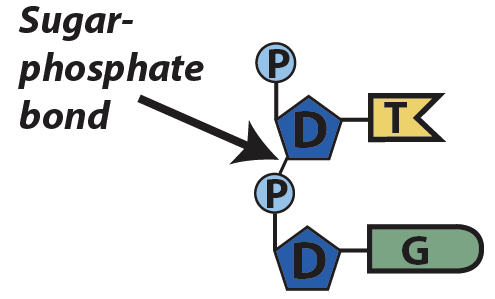
1. The nucleotides connect through sugar-phosphate bonds. These are covalent bonds between the phosphate group of one nucleotide and the deoxyribose sugar of the next nucleotide.
2. Through connecting one nucleotide to the next, a cell (or a chemist) can create a single strand of any length. The diagram below shows ten nucleotides chained together. In your chromosomes, tens or hundreds of millions of nucleotides are chained together.

3. The sequence of nucleotides can be in any order. Whereas the strand above runs, from left to right, G-T-C-A-G-T-C-A-G-T, any sequence is possible. Again, it’s like an alphabet. You can put letters together in any order to spell out words. In DNA, you can put nucleotides together in any order to spell out genes, which are instructions for making proteins. The flexibility of this system gives DNA the power to be the language of life.
4. The chain of deoxyribose sugars and phosphates is known as the sugar-phosphate backbone. The function of the sugar-phosphate backbone is completely structural. By contrast, the function of the bases is to store and provide information.
6. The two strands of DNA are held together by hydrogen bonds between complementary nitrogenous bases
To understand DNA’s structure as a double-stranded molecule, we need to take another look at the nucleotide monomers that make up DNA.
6.a. DNA’s structure is based on the fact that each nucleotide has a shape that complements one (and only one) other nucleotide.
Let’s make sure we understand the terms complement and complementary before proceeding. Note the spelling! This is a different word than “to compliment” (with an “i”) which means “to say something nice.”
- As a verb, to complement means “to complete, to fit, or to go together with.” When I’m dressing well, the color of my shirt complements the color of my pants. In Mexican cuisine, beans complement rice.
- As an adjective, complementary means “fitting together,” as in complementary colors.
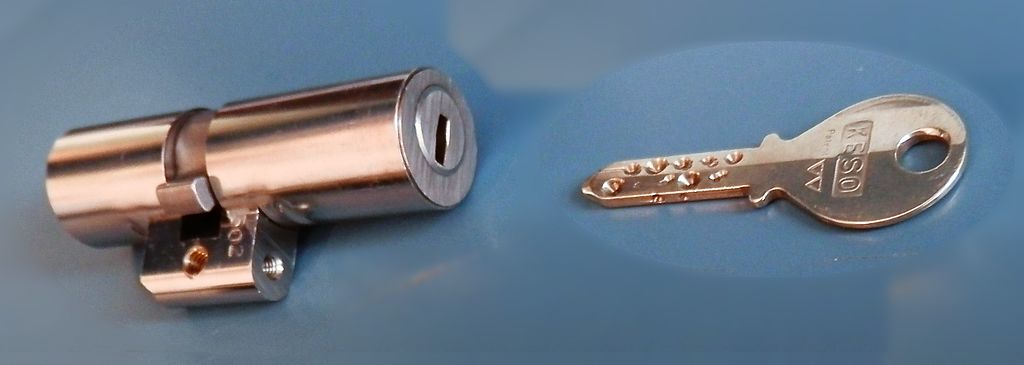 Complementarity is familiar part of life. A key is cut to have a shape that complements the lock of a door. The beak of hummingbird complements the shape of the flowers that the hummingbird pollinates and gets nectar from. Enzymes — proteins that catalyze chemical reactions in cells and organs — have a shape that complements the molecules they interact with. Signaling molecules like hormones have a shape that complements cellular receptors.
Complementarity is familiar part of life. A key is cut to have a shape that complements the lock of a door. The beak of hummingbird complements the shape of the flowers that the hummingbird pollinates and gets nectar from. Enzymes — proteins that catalyze chemical reactions in cells and organs — have a shape that complements the molecules they interact with. Signaling molecules like hormones have a shape that complements cellular receptors.
Figure 6: Complementarity is also a key part of DNA.
6b. DNA’s base-pairing rules: Adenine and Thymine are complementary; Guanine and Cytosine are complementary
Complementarity among DNA bases is based on both size and shape. When they’re positioned upside-down relative to one another (as shown below), adenine will snuggle together with thymine. The width of this adenine-thymine base pair is 2 nanometers. The same is true for guanine and cytosine. You might remember from above that 2 nanometers is the width of DNA. Now you know why.
Adenine and Thymine |
Guanine and Cytosine |
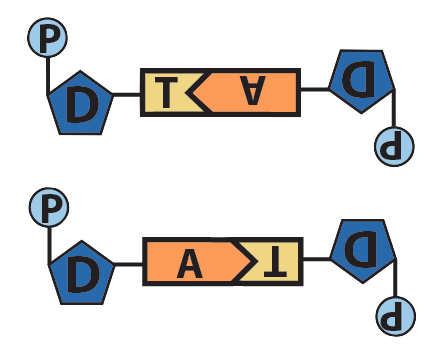 |
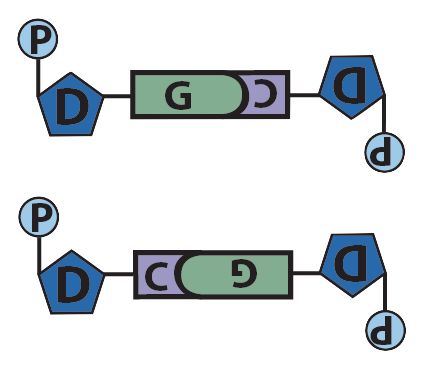 |
The complementarity between A:T and C:G is important. Memorize the nonsense word “ATGaC,” and you’ll be able to remember it.
6c. Hydrogen bonding
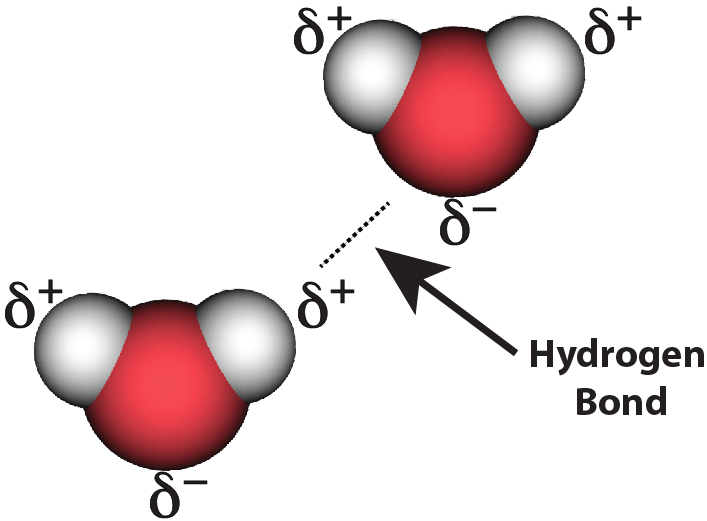
The A:T and C:G base pairs described above don’t only fit together: they also hold onto each other. The bond that connects adenine to thymine or cytosine to guanine is a hydrogen bond.
Hydrogen bonds are relatively weak chemical bonds. They often form between molecules. An example that you might be familiar with is hydrogen bonding between water molecules, shown at left in figure 7.
In DNA, the hydrogen bonds are within the molecule. In the nitrogenous bases, exposed hydrogen atoms have partial positive charges. Exposed nitrogen or oxygen atoms have partial negative charges. As you can see below, hydrogen bonds form between oxygen and hydrogen, or nitrogen and hydrogen.
| The dotted lines between complementary bases indicate hydrogen bonds | |
| Guanine-Cytosine | Adenine-Thymine |
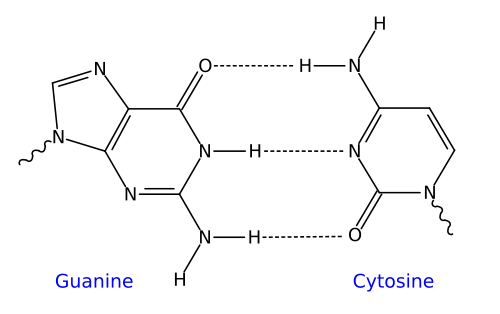 |
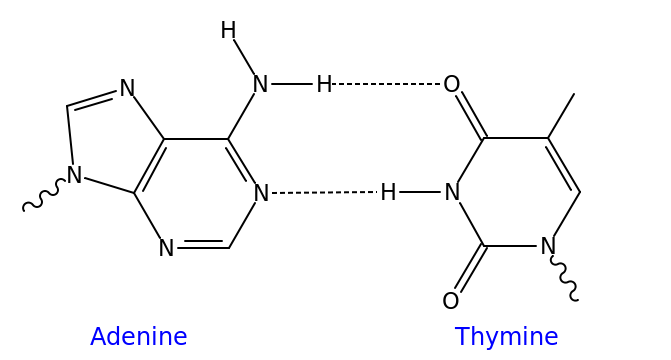 |
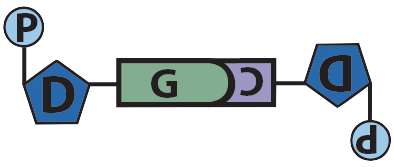 |
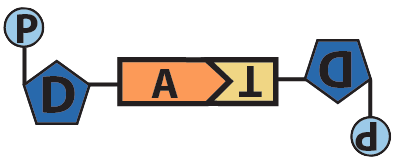 |
These hydrogen bonds play a key role in both DNA’s structure and function. Structurally, they hold the two strands together. Functionally, they make the molecule easy to replicate. That’s because the hydrogen bonds, as chemical bonds go, are relatively weak. They can easily be broken by enzymes. When the two strands separated, each single strand can serve as a template for synthesis of a new strand. Replication is a topic we’ll take on in the next tutorial.
For now, study this flattened-out (non-spiral) depiction of DNA that shows its double stranded structure. Note the base pairing. See if you can identify where the hydrogen bonds are, and where the covalent bonds are. When you’re ready, take the quiz below.

7. Base Pair, Hydrogen Bond Practice
[qwiz style=”width: 648px; border: 2px solid black; ” qrecord_id=”sciencemusicvideosMeister1961-DNA, Hydrogen Bonding, Base Pairing (HS)”]
[h]Base Pair, Hydrogen Bond Practice
[q labels = “top”]
| matching nucleotide |
___ |
___ |
___ |
___ |
___ |
___ |
___ |
___ |
___ |
| 1st nucleotide |
A |
T |
A |
G |
C |
C |
G |
T |
A |
[
[fx] No, that’s not correct. Please try again.
[f*] Great!
[
[fx] No, that’s not correct. Please try again.
[f*] Correct!
[
[fx] No, that’s not correct. Please try again.
[f*] Excellent!
[
[fx] No, that’s not correct. Please try again.
[f*] Great!
[q labels = “top”]
[l]hydrogen bond
[fx] No. Please try again.
[f*] Good!
[l]covalent bond
[fx] No, that’s not correct. Please try again.
[f*] Excellent!
[x]
[restart]
[/qwiz]
8. DNA: An interactive, guided walk-through
[qwiz qrecord_id=”sciencemusicvideosMeister1961-DNA, Guided Walk Through (HS)”]
[h]DNA: An interactive walk-through
[i]Let’s see if we can pull together everything we’ve learned above by analyzing a short section of DNA, as is shown in the models below.
[q]Which number in the diagram below corresponds to a nucleotide?
[textentry single_char=”true”]
[c]NQ ==[Qq]
[f]IFllcy4g4oCcNeKAnSBpcyBhIHNpbmdsZSBudWNsZW90aWRlOiB5b3UgY2FuIHNlZSB0aGUgZGVveHlyaWJvc2Ugc3VnYXIsIGEgcGhvc3BoYXRlLCBhbmQgYSBuaXRyb2dlbm91cyBiYXNlLg==[Qq]
[c]Kg==[Qq]
[f]Tm8uIEJ1dCBoZXJlJiM4MjE3O3MgYSBoaW50LiBOdWNsZW90aWRlcyBoYXZlIDMgcGFydHM6IGEgZGVveHlyaWJvc2Ugc3VnYXIsIGEgcGhvc3BoYXRlLCBhbmQgYSBuaXRyb2dlbm91cyBiYXNlLiBGaW5kIG9uZSB0aGluZyB0aGF0IGhhcyBhbGwgdGhyZWUgb2YgdGhlc2Uu[Qq]
[q]Which number in the diagram below shows hydrogen bonds?
[textentry single_char=”true”]
[c]Ng ==[Qq]
[f]IFllcy4g4oCcNuKAnSBzaG93cyBoeWRyb2dlbiBib25kcyBiZXR3ZWVuIHR3byBuaXRyb2dlbm91cyBiYXNlcy4=[Qq]
[c]Kg==[Qq]
[f]Tm8uIEJ1dCBoZXJlJiM4MjE3O3MgYSBoaW50LiBUaGUgaHlkcm9nZW4gYm9uZHMgYXJlIGluIHRoZSBtaWRkbGUgb2YgRE5BLiBUaGV5IGNvbm5lY3QgY29tcGxlbWVudGFyeSBiYXNlcy4=[Qq]
[q]Which number in the diagram represents the sugar-phosphate backbone of DNA?
[textentry single_char=”true”]
[c]Nw ==[Qq]
[f]IFllcy4g4oCcN+KAnSByZXByZXNlbnRzIHRoZSBzdWdhci1waG9zcGhhdGUgYmFja2JvbmUu[Qq]
[c]Kg==[Qq]
[f]Tm8uIEJ1dCBoZXJlJiM4MjE3O3MgYSBoaW50LiBUaGluayBvZiB5b3VyIGJhY2tib25lLiBBIGJhY2tib25lIGlzIGxvbmcuwqAgSXQmIzgyMTc7cyBtYWRlIG9mIHJlcGVhdGluZyB1bml0cy4gV2hhdCYjODIxNztzIHRoZSBvbmx5IHRoaW5nIG9uIHRoaXMgZGlhZ3JhbSB0aGF0IGNvdWxkIGZpdCB0aGF0IGRlc2NyaXB0aW9uPw==[Qq]
[q]Which number in the diagram below is pointing to nitrogenous bases?
[textentry single_char=”true”]
[c]NA ==[Qq]
[f]IFllcy4g4oCcNOKAnSBpcyBwb2ludGluZyB0byB0d28gbml0cm9nZW5vdXMgYmFzZXMu[Qq]
[c]Kg==[Qq]
[f]Tm8uIEJ1dCBoZXJlJiM4MjE3O3MgYSBoaW50LiBUaGUgc3VnYXItcGhvc3BoYXRlIGJhY2tib25lIGlzIG9uIHRoZSBvdXRzaWRlIG9mIHRoZSBtb2xlY3VsZS4gVGhlIGJhc2VzIGFyZSBvbiB0aGUgaW5zaWRlLiBXaGljaCBhcnJvdyBpcyBwb2ludGluZyB0byB0d28gbml0cm9nZW5vdXMgYmFzZXM/[Qq]
[q]The nucleotide units that make up DNA are connected to one another by sugar-phosphate bonds. Which number below shows sugar-phosphate bonds?
[textentry single_char=”true”]
[c]Mw ==[Qq]
[f]IFllcy4g4oCcM+KAnSBpcyBzaG93aW5nIHN1Z2FyLXBob3NwaGF0ZSBib25kcy4=[Qq]
[c]Kg==[Qq]
[f]Tm8uIEJ1dCBoZXJlJiM4MjE3O3MgYSBoaW50LiBGaW5kIGEgZGVveHlyaWJvc2Ugc3VnYXIgYW5kIGEgdGhlbiBmaW5kIGEgcGhvc3BoYXRlLiBXaGljaCBhcnJvdyBpcyBwb2ludGluZyB0byBhIGJvbmQgdGhhdCBjb25uZWN0cyB0aGVtIHRvZ2V0aGVyPw==[Qq]
[q]Which number in the diagram is pointing to phosphate groups?
[textentry single_char=”true”]
[c]Mg ==[Qq]
[f]IFllcy4g4oCcMuKAnSBpcyBhIHBvaW50aW5nIHRvIHR3byBwaG9zcGhhdGUgZ3JvdXBzLg==[Qq]
[c]Kg==[Qq]
[f]Tm8uIEJ1dCBoZXJlJiM4MjE3O3MgYSBoaW50LiBBIHBob3NwaGF0ZSBncm91cCBoYXMgYSBjZW50cmFsIHBob3NwaG9ydXMgYXRvbSwgdGhlIHN5bWJvbCBmb3Igd2hpY2ggaXMgJiM4MjIwO1AuJiM4MjIxOw==
Cg==[Qq]
[q]Which number in the diagram below corresponds to a nucleotide?
[textentry single_char=”true”]
[c]NQ ==[Qq]
[f]IFllcy4g4oCcNeKAnSBpcyBhIHNpbmdsZSBudWNsZW90aWRlOiB5b3UgY2FuIHNlZSB0aGUgZGVveHlyaWJvc2Ugc3VnYXIsIGEgcGhvc3BoYXRlLCBhbmQgYSBuaXRyb2dlbm91cyBiYXNlLg==[Qq]
[c]Kg==[Qq]
[f]Tm8uIEJ1dCBoZXJlJiM4MjE3O3MgYSBoaW50LiBOdWNsZW90aWRlcyBoYXZlIDMgcGFydHM6IGEgZGVveHlyaWJvc2Ugc3VnYXIsIGEgcGhvc3BoYXRlLCBhbmQgYSBuaXRyb2dlbm91cyBiYXNlLiBGaW5kIG9uZSB0aGluZyB0aGF0IGhhcyBhbGwgdGhyZWUgb2YgdGhlc2Uu[Qq]
[q]Which number in the diagram below shows hydrogen bonds?
[textentry single_char=”true”]
[c]Mw ==[Qq]
[f]IFllcy4g4oCcM+KAnSBzaG93cyBoeWRyb2dlbiBib25kcyBiZXR3ZWVuIHR3byBuaXRyb2dlbm91cyBiYXNlcy4=[Qq]
[c]Kg==[Qq]
[f]Tm8uIEJ1dCBoZXJlJiM4MjE3O3MgYSBoaW50LiBUaGUgaHlkcm9nZW4gYm9uZHMgYXJlIGluIHRoZSBtaWRkbGUgb2YgRE5BLiBUaGV5IGNvbm5lY3QgY29tcGxlbWVudGFyeSBiYXNlcy4=[Qq]
[q]Which number in the diagram represents the sugar-phosphate backbone of DNA?
[textentry single_char=”true”]
[c]NA ==[Qq]
[f]IFllcy4g4oCcNOKAnSByZXByZXNlbnRzIHRoZSBzdWdhciBwaG9zcGhhdGUgYmFja2JvbmUu[Qq]
[c]Kg==[Qq]
[f]Tm8uIEJ1dCBoZXJlJiM4MjE3O3MgYSBoaW50LiBUaGluayBvZiB5b3VyIGJhY2tib25lLiBBIGJhY2tib25lIGlzIGxvbmcuwqAgSXQmIzgyMTc7cyBtYWRlIG9mIHJlcGVhdGluZyB1bml0cy4gV2hhdCYjODIxNztzIHRoZSBvbmx5IHRoaW5nIG9uIHRoaXMgZGlhZ3JhbSB0aGF0IGNvdWxkIGZpdCB0aGF0IGRlc2NyaXB0aW9uPw==[Qq]
[q]Which number in the diagram below is pointing to a single nitrogenous base (“C” or “T,” for example)?
[textentry single_char=”true”]
[c]Mg ==[Qq]
[f]IFllcy4g4oCcMuKAnSBpcyBwb2ludGluZyB0byBvbmUgb2YgdGhlIG5pdHJvZ2Vub3VzIGJhc2VzIGluIEROQS4=[Qq]
[c]Kg==[Qq]
[f]Tm8uIEJ1dCBoZXJlJiM4MjE3O3MgYSBoaW50LiBUaGUgc3VnYXItcGhvc3BoYXRlIGJhY2tib25lIGlzIG9uIHRoZSBvdXRzaWRlIG9mIHRoZSBtb2xlY3VsZS4gVGhlIGJhc2VzIGFyZSBvbiB0aGUgaW5zaWRlLiBXaGljaCBhcnJvdyBpcyBwb2ludGluZyB0byBqdXN0IG9uZSBiYXNlLg==[Qq]
[q]The nucleotides units that make up DNA are connected to one another by sugar-phosphate bonds. Which number below shows a single, sugar-phosphate bond?
[textentry single_char=”true”]
[c]Nw ==[Qq]
[f]IFllcy4g4oCcN+KAnSBpcyBhIHN1Z2FyLXBob3NwaGF0ZSBib25k[Qq]
[c]Kg==[Qq]
[f]Tm8uIEJ1dCBoZXJlJiM4MjE3O3MgYSBoaW50LiBGaW5kIGEgZGVveHlyaWJvc2Ugc3VnYXIgYW5kIGEgdGhlbiBmaW5kIGEgcGhvc3BoYXRlLiBXaGljaCBhcnJvdyBpcyBwb2ludGluZyB0byBhIGJvbmQgdGhhdCBjb25uZWN0cyB0aGVtIHRvZ2V0aGVyPw==[Qq]
[q]Which number in the diagram is pointing to a phosphate group?
[textentry single_char=”true”]
[c]Ng ==[Qq]
[f]IFllcy4g4oCcNuKAnSBpcyBhIHBvaW50aW5nIHRvIGEgcGhvc3BoYXRlIGdyb3VwLg==[Qq]
[c]Kg==[Qq]
[f]Tm8uIEJ1dCBoZXJlJiM4MjE3O3MgYSBoaW50LiBBIHBob3NwaGF0ZSBncm91cCBoYXMgYSBjZW50cmFsIHBob3NwaG9ydXMgYXRvbSwgdGhlIHN5bWJvbCBmb3Igd2hpY2ggaXMgJiM4MjIwO1AuJiM4MjIxOw==[Qq]
[/qwiz]
9. DNA: Three Final Points
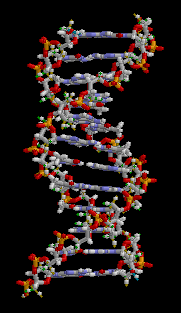
At this point, you should have a good understanding of the structure of DNA. Here are a few final points.
1. You already know that DNA is an acronym for deoxyribonucleic acid. To review
- The deoxyribo- part refers to the sugar, deoxyribose.
- The nucleic part refers to the fact that DNA is found in the nucleus of eukaryotic cells.
- The acid part refers to DNA’s chemistry: DNA is acidic.
2. Another helpful metaphor for DNA’s structure is to think of it as a twisted ladder. The sides of the ladder make up DNA’s sugar-phosphate backbone. The paired nitrogenous bases in the center of the molecule are the rungs of the ladder (the things that you step on as you climb the ladder). You might also think of a double corkscrew.
3. The Nobel Prize for the discovery of DNA’s structure went to James Watson, Francis Crick, and Maurice Wilkins, who received their prize in 1962 for work that was published in 1953. A fourth contributor to their efforts was Rosalind Franklin, who died in 1958 (and thus could not share in the prize). Franklin’s work was essential in helping Watson and Crick understand the geometry of the double helix, enabling them to create an accurate model.
The key dimensions of what’s called the Watson-Crick model of DNA are as follows:
- The width of the double helix is two nanometers (two billionths of a meter). This is represented by letter “o” in the diagram to the right.
- The distance between two adjacent base-pairs is 0.34 nanometer, represented by “n” at right.
- It takes 10 nucleotides in a row for the helix to make one complete turn (which you can also think of as the wavelength of the helix). One turn, in other words, is 3.4 nanometers long, a distance represented by “m” in the diagram at right.
10. Quiz: DNA Structure
On the quiz that follows, you’ll see questions from this tutorial, and from the last one. You’ll also see diagrams of DNA that you haven’t yet seen. All of this will help deepen your understanding and consolidate your memory.
As with all the quizzes on our site,
- Each question is multiple choice or fill-in-the-blanks, but the entire quiz is like a series of flashcards.
- If you get the question right, it comes off the deck.
- If you get the question wrong, it goes to the bottom of the deck, so you can try it again.
[qwiz style=”border:3px solid black; ” random = “false” qrecord_id=”sciencemusicvideosMeister1961-DNA Structure (HS)”]
[h] Quiz: DNA Structure
[i]
[q labels=”top”]All the the four nucleotides in DNA are the same because they have a _______________ sugar and a _____________ group. They’re different because they have a distinct ______________ base.
[l]nitrogenous
[fx] No. Please try again.
[f*] Great!
[l]deoxyribose
[fx] No. Please try again.
[f*] Great!
[l]phosphate
[fx] No, that’s not correct. Please try again.
[f*] Great!
[q]A common name to describe DNA’s shape is double [hangman].
[c]aGVsaXg=[Qq]
[q]To describe the matching fit between certain nucleotides we would say that adenine is [hangman] to thymine
[c]Y29tcGxlbWVudGFyeQ==[Qq]
[q]In DNA, thymine always bonds with
[c]Y3l0b3NpbmU=[Qq]
[f]Tm8uIEp1c3QgcmVtZW1iZXIgdGhhdCBBIGJvbmRzIHdpdGggVCwgYW5kIEMgYm9uZHMgd2l0aCBHLg==[Qq]
[c]YWRlbm luZQ==[Qq]
[f]TmljZS4gVGh5bWluZSBpcyBjb21wbGVtZW50YXJ5IHRvIGFkZW5pbmUu[Qq]
[c]Z3VhbmluZQ==[Qq]
[f]Tm8uIEp1c3QgcmVtZW1iZXIgdGhhdCBBIGJvbmRzIHdpdGggVCwgYW5kIEMgYm9uZHMgd2l0aCBHLg==[Qq]
[q]The bonds connecting complementary base pairs are ________ bonds.
[hangman]
[c]aHlkcm9nZW4=[Qq]
[f]VGhlIGJvbmRzIGNvbm5lY3RpbmcgY29tcGxlbWVudGFyeSBiYXNlIHBhaXJzIGFyZSA=aHlkcm9nZW4=IGJvbmRzLg==[Qq]
[q]The central dogma of molecular genetics is DNA makes [hangman] makes protein
[c]Uk5B[Qq]
[f]VGhlIGNlbnRyYWwgZG9nbWEgb2YgbW9sZWN1bGFyIGdlbmV0aWNzIGlzIEROQSBtYWtlcyA=Uk5BIG1ha2VzIHByb3RlaW4u[Qq]
[q]DNA stores genetic [hangman].
[c]aW5mb3JtYXRpb24=[Qq]
[f]WWVzLiBETkEgc3RvcmVzIGdlbmV0aWPCoA==aW5mb3JtYXRpb24=Lg==[Qq]
[q]The molecule (shown at 5 below) that brings DNA information from the nucleus to the cytoplasm is [hangman]
[c]Uk5B[Qq]
[f]WWVzLiBUaGUgbW9sZWN1bGUgdGhhdCBicmluZ3MgRE5BIGluZm9ybWF0aW9uIGZyb20gdGhlIG51Y2xldXMgdG8gdGhlIGN5dG9wbGFzbSBpcyA=Uk5BLg==[Qq]
[q] In the diagram of a DNA molecule below, which number is pointing to a phosphate group?
[c]IDE=[Qq]
[c]IDI=[Qq]
[c]wq Az[Qq]
[c]wqA0[Qq]
[c]wqA1[Qq]
[c]wqA2[Qq]
[c]wqA3[Qq]
[c]wqA4[Qq]
[c]wqA5[Qq]
[f]Tm8uIE51bWJlciAxIGluZGljYXRlc8KgdGhlIHN1Z2FyIHBob3NwaGF0ZSBiYWNrYm9uZS4=[Qq]
[f]Tm8uIE51bWJlciAyIGluZGljYXRlcyBhIHN1Z2FyLXBob3NwaGF0ZSBib25kLg==[Qq]
[f]WWVzLiBOdW1iZXIgMyBpbmRpY2F0ZXMgYSBwaG9zcGhhdGUgZ3JvdXAu[Qq]
[f]Tm8uIE51bWJlciA0IGluZGljYXRlcyBkZW94eXJpYm9zZS4=
[f]Tm8uIE51bWJlciA1IGluZGljYXRlcyB0aGUgbml0cm9nZW5vdXPCoGJhc2VzIA==YWRlbmluZQ==Lg==[Qq]
[f]Tm8uIE51bWJlciA2IGluZGljYXRlcyB0aGUgbml0cm9nZW5vdXMgYmFzZXMgdGh5bWluZQ==Lg==[Qq]
[f]Tm8uIE51bWJlciA3IGluZGljYXRlcyBoeWRyb2dlbiBib25kcy4=[Qq]
[f]Tm8uIE51bWJlciA4IGluZGljYXRlcyB0aGUgbml0cm9nZW5vdXMgYmFzZSA=Y3l0b3NpbmU=Lg==
[f]Tm8uIE51bWJlciA5IGluZGljYXRlcyB0aGUgbml0cm9nZW5vdXMgYmFzZSA=Z3VhbmluZQ==Lg==
Cg==[Qq]
[q labels = “top”]
[l]deoxyribose
[fx] No, that’s not correct. Please try again.
[f*] Good!
[l]hydrogen bonds
[fx] No, that’s not correct. Please try again.
[f*] Excellent!
[l]nitrogenous base
[fx] No. Please try again.
[f*] Great!
[l]nucleotide
[fx] No. Please try again.
[f*] Correct!
[l]phosphate group
[fx] No. Please try again.
[f*] Good!
[l]sugar-phosphate backbone
[fx] No. Please try again.
[f*] Great!
[l]sugar-phosphate bond
[fx] No, that’s not correct. Please try again.
[f*] Good!
[q labels = “top”]
[l]phosphate group
[fx] No, that’s not correct. Please try again.
[f*] Excellent!
[l]nitrogenous base
[fx] No, that’s not correct. Please try again.
[f*] Correct!
[l]deoxyribose sugar
[fx] No, that’s not correct. Please try again.
[f*] Excellent!
[q] In the diagram of a DNA molecule below, which number is pointing to the sugar-phosphate backbone?
[c]ID E=[Qq]
[c]IDI=[Qq]
[c]wqAz[Qq]
[c]wqA0[Qq]
[c]wqA1[Qq]
[c]wqA2[Qq]
[c]wqA3[Qq]
[f]WWVzLiBOdW1iZXIgMSBpbmRpY2F0ZXPCoHRoZSBzdWdhciBwaG9zcGhhdGUgYmFja2JvbmUu[Qq]
[f]Tm8uIE51bWJlciAyIGluZGljYXRlcyBhIHN1Z2FyLXBob3NwaGF0ZSBib25kLg==[Qq]
[f]Tm8uIE51bWJlciAzIGluZGljYXRlcyBhIHBob3NwaGF0ZSBncm91cC4=[Qq]
[f]Tm8uIE51bWJlciA0IGluZGljYXRlcyBkZW94eXJpYm9zZS4=
[f]Tm8uIE51bWJlciA1IGluZGljYXRlcyB0aGUgbml0cm9nZW5vdXPCoGJhc2VzIA==YWRlbmluZQ==Lg==[Qq]
[f]Tm8uIE51bWJlciA2IGluZGljYXRlcyB0aGUgbml0cm9nZW5vdXMgYmFzZXMgdGh5bWluZQ==Lg==[Qq]
[f]Tm8uIE51bWJlciA3IGluZGljYXRlcyBoeWRyb2dlbiBib25kcy4=
[Qq]
[q labels = “top”]
[l]RNA
[fx] No, that’s not correct. Please try again.
[f*] Great!
[l]translation of RNA to protein
[fx] No, that’s not correct. Please try again.
[f*] Correct!
[l]DNA
[fx] No, that’s not correct. Please try again.
[f*] Excellent!
[l]cell membrane
[fx] No. Please try again.
[f*] Excellent!
[l]cytoplasm
[fx] No, that’s not correct. Please try again.
[f*] Good!
[l]protein
[fx] No, that’s not correct. Please try again.
[f*] Good!
[l]transcription of DNA to RNA
[fx] No, that’s not correct. Please try again.
[f*] Great!
[l]nuclear membrane
[fx] No, that’s not correct. Please try again.
[f*] Excellent!
[q] In the diagram of a DNA molecule below, which number represents hydrogen bonds?
[c]wqAx[Qq]
[c]wqAy[Qq]
[c]wqAz[Qq]
[c]wqA0[Qq]
[c]wq A3[Qq]
[f]Tm8uIE51bWJlciAxIGluZGljYXRlc8KgdGhlIHN1Z2FyIHBob3NwaGF0ZSBiYWNrYm9uZS4=[Qq]
[f]Tm8uIE51bWJlciAyIGluZGljYXRlcyBhIHN1Z2FyLXBob3NwaGF0ZSBib25kLg==[Qq]
[f]WWVzLiBOdW1iZXIgMyBpbmRpY2F0ZXMgYSBwaG9zcGhhdGUgZ3JvdXAu[Qq]
[f]Tm8uIE51bWJlciA0IGluZGljYXRlcyBkZW94eXJpYm9zZS4=
[f]WWVzLiBOdW1iZXIgNyBpbmRpY2F0ZXMgaHlkcm9nZW4gYm9uZHMu
Cg==[Qq]
[q]Which letter in the diagram below corresponds to a distance between two adjacent base pairs?
[textentry single_char=”true”]
[c]bg ==[Qq]
[f]IFllcy4g4oCcbuKAnSBpcyB0aGUgZGlzdGFuY2UgYmV0d2VlbiB0d28gYWRqYWNlbnQgYmFzZSBwYWlycyAod2hpY2ggaXMgMC4zNCBuYW5vbWV0ZXJzKS4=[Qq]
[c]Kg==[Qq]
[f]Tm8uIEJ1dCBoZXJlJiM4MjE3O3MgYSBoaW50LiBJdCYjODIxNztzIHRoZSBzbWFsbGVzdCBtZWFzdXJlZCBkaW1lbnNpb24gb24gdGhpcyBkaWFncmFtLg==
Cg==[Qq]
[q]Which number is the sugar deoxyribose?
[textentry single_char=”true”]
[c]ID E=[Qq]
[f]IFllcy4g4oCcMeKAnSBpc8KgZGVveHlyaWJvc2U=[Qq]
[c]Kg==[Qq]
[f]Tm8uIEhlcmUmIzgyMTc7cyBhIGhpbnQuwqBEZW94eXJpYm9zZSBpcyBhIGZpdmUgY2FyYm9uIHN1Z2FyLiBJdCYjODIxNztzIHN0cnVjdHVyYWwgZm9ybXVsYSBpcyBhIHBlbnRhZ29uLg==
Cg==[Qq]
[q]Which number indicates hydrogen bonds?
[textentry single_char=”true”]
[c]ID Y=[Qq]
[f]IFllcy4g4oCcNuKAnSByZXByZXNlbnRzIGh5ZHJvZ2VuIGJvbmRzLg==[Qq]
[c]Kg==[Qq]
[f]Tm8uIEhlcmUmIzgyMTc7cyBhIGhpbnQuIEh5ZHJvZ2VuIGJvbmRzIGFyZSBiZXR3ZWVuIHRoZSBiYXNlcyBpbiBjb21wbGVtZW50YXJ5IG51Y2xlb3RpZGVzLg==
Cg==[Qq]
[q]Which number is the sugar-phosphate backbone?
[textentry single_char=”true”]
[c]ID Q=[Qq]
[f]IFllcy4g4oCcNOKAnSBpc8KgdGhlIHN1Z2FyIHBob3NwaGF0ZSBiYWNrYm9uZS4=[Qq]
[c]Kg==[Qq]
[f]Tm8uIEhlcmUmIzgyMTc7cyBhIGhpbnQuIEEgYmFja2JvbmUgaXMgcHJldHR5IGxvbmcuIFdoYXQmIzgyMTc7cyB0aGUgbG9uZ2VzdCBzdHJ1Y3R1cmUgb24gdGhpcyBkaWFncmFtPw==
Cg==[Qq]
[q]Which number is an entire nucleotide?
[textentry single_char=”true”]
[c]NQ ==[Qq]
[f]IFllcy4g4oCcNeKAnSBpc8KgYW4gZW50aXJlIG51Y2xlb3RpZGU=[Qq]
[c]Kg==[Qq]
[f]Tm8uIEhlcmUmIzgyMTc7cyBhIGhpbnQuwqBUaGUgbnVjbGVvdGlkZSBoYXMgdGhyZWUgc3VicGFydHM6IGEgc3VnYXIsIGEgcGhvc3BoYXRlIGdyb3VwLCBhbmQgYSBuaXRyb2dlbm91cyBiYXNlLiBXaGVyZSBkbyB5b3Ugc2VlwqBhbGwgdGhyZWUgb2YgdGhlc2UgYXMgb25lIGxhYmVsZWQgcGFydCBvZiB0aGUgZGlhZ3JhbT8=
Cg==[Qq]
[q]Which number indicates a sugar-phosphate bond.
[textentry single_char=”true”]
[c]Nw ==[Qq]
[f]IFllcy4g4oCcN+KAnSByZXByZXNlbnRzIGEgc3VnYXItcGhvc3BoYXRlIGJvbmQu[Qq]
[c]Kg==[Qq]
[f]Tm8uIEhlcmUmIzgyMTc7cyBhIGhpbnQuIExvb2sgZm9yIGEgYm9uZCBjb25uZWN0aW5nIGEgc3VnYXIgYW5kIGEgcGhvc3BoYXRlIGdyb3VwLg==[Qq]
[q]The units or building blocks of DNA (one of which is shown below) are called [hangman].
[c]bnVjbGVvdGlkZXM=[Qq]
[f]WWVzLiBUaGUgbW9ub21lcnMgb2YgbnVjbGVpYyBhY2lkc8KgYXJlIA==bnVjbGVvdGlkZXM=Lg==
Cg==[Qq][q]In DNA, cytosine always bonds with
[c]QQ==[Qq]
[f]Tm8uIFJlbWVtYmVyIHRoZSBub25zZW5zZSB3b3JkICYjODIyMDtBVEdhQyEmIzgyMjE7[Qq]
[c]VA==[Qq]
[f]Tm8uIFJlbWVtYmVyIHRoZSBub25zZW5zZSB3b3JkICYjODIyMDtBVEdhQyEmIzgyMjE7[Qq]
[c]Rw ==[Qq]
[f]WWVzLiBJbiBETkEsIGN5dG9zaW5lwqAgKEMpIGFsd2F5cyBib25kcyB3aXRoIGd1YW5pbmUgKEcp
Cg==Cg==[Qq][q]In a DNA nucleotide, the sugar is
[hangman]
[c]ZGVveHlyaWJvc2U=[Qq]
[f]SW4gYSBETkEgbnVjbGVvdGlkZSwgdGhlIHN1Z2FyIGlzIA==ZGVveHlyaWJvc2U=Lg==[Qq]
[q]In eukaryotic cells, the DNA in the nucleus is organized into [hangman] (one of which is shown at “4”).
[c]Y2hyb21vc29tZXM=[Qq]
[f]WWVzLiBJbiBldWthcnlvdGljIGNlbGxzLCB0aGUgRE5BIGluIHRoZSBudWNsZXVzIGlzIG9yZ2FuaXplZCBpbnRvIA==Y2hyb21vc29tZXM=Lg==[Qq]
[q]A unit of heredity is a
[hangman]
[c]Z2VuZQ==[Qq]
[f]Q29ycmVjdC4gQSB1bml0IG9mIGhlcmVkaXR5IGlzIGEgZ2VuZQ==Lg==[Qq]
[x]
If you want to take this quiz again, click the button below
[restart]
[/qwiz]
Links to:
- DNA Replication (next HS level tutorial)
- DNA structure and Replication (HS Level) Menu
- DNA, Fantastic! (music video)
Notes
- There are a few exceptions. Red blood cells don’t have a nucleus or DNA.


